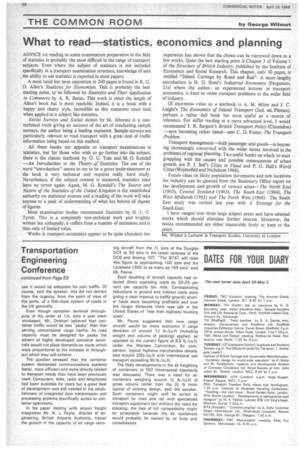THE COMMON ROOM by George Wilmot
Page 68

If you've noticed an error in this article please click here to report it so we can fix it.
What to read statistics, economics and planning
ADVICE on reading to assist examination preparation in the field of statistics is probably the most difficult in the range of transport subjects. Even where the subject of statistics is not included specifically in a transport examination structure, knowledge of and the ability to use statistics is expected in most papers.
A most lucid but terse exposition in 200 pages is found in R. G. D. Allen's Statistics for Economists. This is probably the best starting point, to be followed by Statistics and Their Application to Commerce by A. R. Ilersic. This work is twice the length of Allen's book but is most readable, Indeed, it is a book with a happy and chatty style, incredible as this statement must look when applied to a subject like statistics.
Social Surveys and Social Action by M. Abrams is a nontechnical book giving an account of the art of conducting sample surveys, the author being a leading exponent. Sample surveys are particularly relevant to road transport with a great deal of traffic information being based on this method.
All these books are apposite to transport examinations in statistics, but for those who wish to go further into the subject, there is the classic textbook by G. U. Yule and M. G. Kendall —An Introduction to the Theory of Statistics. The use of the word "introduction" seems to me to be a gross understatement as the book is very technical and requires really hard study. Nevertheless, if the subject content is mastered, statistics need have no terror again. Again, M. G. Kendall's The Source and Nature of the Statistics of the United Kingdom is the established authority on statistical sources and a reading of the work will take anyone to a peak of understanding of what lies behind all digests of figures.
Most examination bodies recommend Statistics by H. L. C. Tyrett. This is a completely non-technical work and brightly written but unhappily, it suffers from a number of omissions and is thus only of limited value.
Works in transport economics appear to be quite abundant but experience has shown that the choice can be narrowed down to a few works. Quite the best starting point is Chapter 3 of Volume 1 of the Structure of British Industry, published by the Institute of Economics and Social Research. This chapter, only 30 pages, is entitled "Inland Carriage by Road and Rail". A more lengthy introduction is H. G. Hunt's Industrial Economics (Pergamon, 21s) where the author, an experienced lecturer in transport economics, is keen to relate transport problems to the wider field of industry.
Of enormous value as a textbook is A. M. Milne and J. C. Laight's The Economics of Inland Transport (2nd. ed. Pitman), perhaps a rather dull book but most useful as a source of reference. For stiffer reading at a more advanced level, I would recommend J. R. Sargent's British Transport Policy (Clarendon) —now becoming rather dated—and C. D. Foster, The Transport Problem, Transport management—both passenger and goods—is becoming increasingly concerned with the wider issues involved in the problems of regional planning. Two useful books on which to start grappling with the causes and possible consequences of urban growth are P. J. Self's Cities in Flood and P. G. Hall's World Cities (Weidenfeld and Nicholson 1966).
Future ideas on likely population movements and new locations for industry can be gleaned from the Stationery Office report on the development and growth of various areas—The North East (1963), Central Scotland (1963), The South East (1964), The West Midlands (1965) and The North West (1966). The South East study was revised last year with A Strategy for the South East.
1 have ranged over three large subject areas and have selected works which should stimulate further interest. Moreover, the books recommended are either reasonably lively or keep to the point.
Mr. Wilmot is Lecturer in Transport Studies, University of London.




















































































































